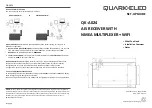
This is an overview only. Familiarize yourself with the manual and the manuals of
any connecting devices before installation. It is always recommended that
electronic equipment be installed by an experienced installer.
QK-A024
BEFORE LEAVING HOME:
We recommend pre-installing the Configuration software and drivers if needed, as you might not
have a CD reader/internet access on site.
Driver and Configuration software are optional and only needed for specific features.
If you will access data on a Mac/Linux/Windows PC:
Driver required for Windows. If using Windows 10, the driver should install automatically, if
not, it is included on the Free CD and at Quark-elec.com.
Driver not required for Mac or Linux.
If you will connect to the A024 through Station mode WiFi:
(e.g. through a router, see page 4)
Configuration software (Windows) required. Driver may be required as above.
If you will adjust NMEA 0183 baud rates:
The NMEA 0183 baud rates are set to 4800bps (input)
and 38400bps (output) as default, as these are the settings used by most input and output NMEA
devices. You can adjust the baud rates if desired, using the Configuration software.
Configuration software (Windows) required. Driver may be required as above.
Configuration Software and specific instructions are on the FREE CD and at www.quark-elec.com.
INSTALLATION
1. Mounting: Consider your location…
Dry, sturdy location 0.5m from other WiFi equipment.
Ensure you have the correct length of cable needed for VHF and the 5.0V power via micro
USB. If drilling holes for your cabling, seal around any holes to prevent damage to your vessel
or equipment.
2. Connect your Antennas: VHF
Connect VHF:
If you want to use one VHF antenna for both AIS and radio (or other purposes),
then you will need an active splitter. An active splitter will protect the A024 and your other
VHF equipment (VHF radio). If not, the two signals will significantly damage each device
connected as well as reducing the signal.
If using two VHF antennas, place them as far away as possible from each other (at least 3
metres).
3. Connect Power
The A024 uses 5.0V power. This is connected via a micro USB. USB cable is provided. This can
connect to a mobile or PC. If a mobile electronic device isn’t available then we recommend using
your vessels battery power. The power must be 5.0V, any higher will damage the A024.
4. Check LED lights are working on the A024
The flashing green light indicates a valid AIS signal is being received by the A024.
Power:
Top LED (red) flashes at 3 second intervals.
AIS
:
Middle LED flashes for each valid message received.
N/A
on this model.
QK-A024
We do not recommend using a cigarette charger.
A low noise power connecter designed for marine applications is available at
www.quark-elec.com/12to5vconverter
5. Disconnect power and connect NMEA input and output if desired
Connect the ‘+’ and ‘-‘ terminals of the NMEA input/output on the A024 to the ‘+’ and ‘-‘
terminals of the output/input on the instrument.
The A024 uses NMEA 0183-RS422. If your connecting device uses the older NMEA 0183-RS232
and you are having issues with your NMEA connection, you may find swapping these
terminals works for your device.
Alternatively, connect it using a Quark-elec Protocol
Bridge (QK-AS03).


